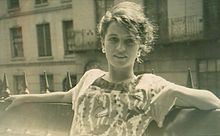Mary White (textile designer)
Mary White | |
|---|---|
 Mary White in 1947 | |
| Born | 22 January 1930 Margate, Kent, England |
| Died | 20 May 2020 (aged 90) Westgate, Kent |
| Nationality | British |
| Other names | Mary Dening |
| Alma mater | Thanet School of Art and Crafts |
| Known for | Textile design and pottery |
Mary Lillian White later Mary Dening (22 January 1930 – 20 May 2020) was an English textile designer known for several iconic textile prints of the 1950s.[1][2] Her designs were very popular and extensively copied in many 1950s homes, as well as in cabins aboard the RMS Queen Mary and at Heathrow Airport.[3] She was also a commercial potter and ceramist, who in the 1960s founded Thanet Pottery, in partnership with her brother David White.[3]
Biography
White was born in 1930,
Textiles
Mary White enjoyed a reputation in the 1950s as one of the leading mid-century fabric, textile and pattern designers of the era. She was prolific in her design creation between 1950 until 1957.[5] In the 1950s she worked as a textile designer contracted with the design studio of David Whitehead, which included other designers and artists such as John Barker, Afro Basaldella, Eileen Bell, Gerald Downes, J. Feldman, Barbara Pile, Humphrey Spender, Robert Tierney, Lisa Gronwall and Maj Nilsson.[5] White was designing during the same period as British textile designer, Lucienne Day.
To create her designs White drew on the work of
White's Coppice patterned textile print was reproduced as a rug and sold in
Examples of White's designs are held by several British museums including the
Pottery
White was also involved in Thanet Pottery, having also studied pottery at Thanet School of Art and Crafts. Thanet Pottery was a collaboration between White (then using her married name of Dening) and her brother, David White.[8] Thanet Pottery made hand painted slip cast earthenware pottery and their items were sold to High Street chains in the early 1960s.
Mary White was interviewed and included in the BBC One show The 1952 Show, Episode 2 which aired on 27 March 2012.[9]
References
- ^ "1950s Textile Designer Mary White meets with FashionCapital". Fashion Capital. Archived from the original on 26 February 2015. Retrieved 4 July 2010.
- ^ Zamora, Yoel Morales. "1950's Textile Designer Mary White meets with FashionCapital". Fashion Capital. Archived from the original on 2 February 2018. Retrieved 29 September 2017.
- ^ a b c d e "Iconic British Textile Designers". Stuart Morris -. 23 May 2014. Retrieved 16 March 2021.
- ^ "Ambleside by White, Mary". V&A Museum Collections. Retrieved 5 June 2018.
- ^ ISBN 978-1568987125 – via Google Books.
- ^ 1950s-designed Honesty Rug from John Lewis. Retro To Go (2010-03-24). Retrieved on 2013-01-07.
- ^ "1950s designs revived". Kent Online. KM Media Group. 28 May 2008. Retrieved 16 March 2021.
- ^ "Thanet Pottery". studiopottery.com. Retrieved 5 June 2018.
- ^ "Episode 2, The 1952 Show - BBC One". BBC. Retrieved 29 September 2017.
Further reading
- Jackson, Lesley: "Twentieth-century Pattern Design: Textile & Wallpaper Pioneers", page 99 and page 103. Princeton Architectural Press, 2002. ISBN 978-1-84000-371-0.
- Fiell, Charlotte and Peter: "Decorative Art 50s", page 294. Taschen, 2008. ISBN 978-3-8365-0310-5.

